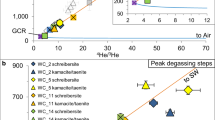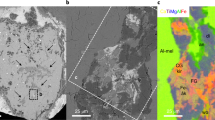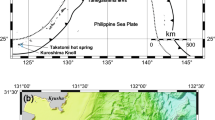Abstract
LORD RAYLEIGH1 reported an excess of neon (over argon) in pumice from the Lipari Islands. Dymond and Hogan2 have reported excesses of neon in mid-oceanic tholeitic basalts and have suggested that they indicate primordial neon. As the search for primordial gases in terrestrial rocks has an important bearing on our understanding of the formation and thermal history of the Earth, we decided to look at the isotopic composition of the neon in pumice from the Lipari Islands. We collected fresh specimens from the largest quarry on the islands and extracted the included gases by crushing in a vacuum line and by stepwise heating. The five noble gases were measured in a mass spectrometer.
This is a preview of subscription content, access via your institution
Access options
Subscribe to this journal
Receive 51 print issues and online access
$199.00 per year
only $3.90 per issue
Buy this article
- Purchase on Springer Link
- Instant access to full article PDF
Prices may be subject to local taxes which are calculated during checkout
Similar content being viewed by others
References
Lord Rayleigh, Proc. R. Soc., A 170, 451 (1939).
Dymond, J., and Hogan, L., Earth planet. Sci. Lett., 20, 131 (1973).
Eberhardt, P., Earth planet. Sci. Lett., 24, 182 (1974).
Author information
Authors and Affiliations
Rights and permissions
About this article
Cite this article
BOCHSLER, P., MAZOR, E. Excess of atmospheric neon in pumice from the Islands of Lipari. Nature 257, 474–475 (1975). https://doi.org/10.1038/257474a0
Received:
Accepted:
Issue Date:
DOI: https://doi.org/10.1038/257474a0
This article is cited by
-
Evolution of fumarolic gases ? boundary conditions set by measured parameters: case study at Vulcano, Italy
Bulletin of Volcanology (1988)
-
Noble gases in a section across the vapor dominated geothermal field of Larderello, Italy
Pure and Applied Geophysics PAGEOPH (1978)
Comments
By submitting a comment you agree to abide by our Terms and Community Guidelines. If you find something abusive or that does not comply with our terms or guidelines please flag it as inappropriate.



